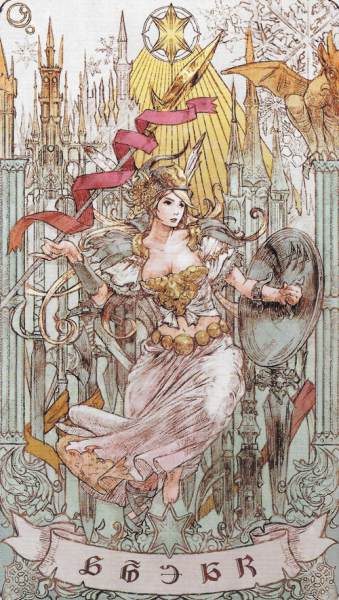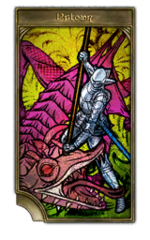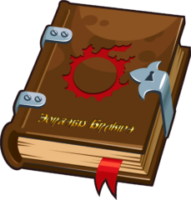Tome Request – Harrow Levesque
Tome Retrieved – ‘On The Twelve and their Aspects – Halone, the Bitterfrost Spear’ by Archon Niniri Niri

Halone is famed as the Mover of Glaciers and Goddess of War, who strides forth with her bronze greatshield and mighty spear. This is reflected in her symbol, a trio of spears and her aspect, as a deity of ice. Halone is the patron of Ishgard, and in the past was the patron of an unknown city-state from the Fifth Astral Era. Some evidence, including that of the Elezen who settled in Coerthas long having worshipped Halone even by the time they arrived, suggests this state may have existed in Central Eorzea, while others point to ancient Dravanian cultures as this state. In the theology of the Twelve, Halone is regarded as the daughter of Rhalgr and sister of Byregot. She is also commonly associated with Oschon as a friend and with Nophica as a rival. Halone, alongside Menphina is represented in the Major Arcana by the Spear and by the suit of Irons in the Deck of Sixty. She is regarded as representing the first moon of the Eorzean Calendar.
Halone’s role in Lewphon’s definitive Tale of Creation – Halone emerges in the tale of Creation as the second youngest of the Twelve, rising alongside her older brother Byregot from the primordial Whorl as figures of chaos in the ordered universe. In order to counter their willful natures Nymeia entrusted them to Rhalgr, that he might raise them and temper their passions. Halone was respectful of Rhalgr where Byregot was ignorant, for her brother was a creator while she, like her father, was a destroyer. Ambitious, Halone desired greatly to test her strength and went on to do so on a journey with Oschon, the Wanderer. As she travelled her bloodlust grew, and she challenged every creature she met on the world, developing new means of battle in the methodical manner of a master warrior and general.
Nophica, as the mother of all life, was enraged by this butchery and reached out to Halone, but found her advances rebuffed by the Fury. Oschon, as friend to Halone, resolved to close this rift and prevent war amongst the gods. He reached within the mountains of the realm, summoning forth a great gout of magma which he shaped into a new deity, the last of the Twelve, the twins Nald and Thal. Nald’thal, a god of two aspects, assumed responsibility of the afterlife, giving those creatures slain by Halone a place in which to rest, allowing peace to reign once more amongst the pantheon. Halone stood alongside her fellow deities and crafted the seven heavens, retreating to them that they might survey creation.

The Hell and Heaven of Ice – Halone carved the Heaven of Ice herself with her spear, a mighty palace comprised entirely of ice. Amongst these hallowed halls walk those who demonstrated benevolence and faith in life, particularly those knights and heroes who embodied gallantry and achieved epic deeds in life. The Heaven of Ice is connected to its sister Hell by long icicles which droop into a massive pit, where the craven and those who desert their duty coexist with adulterers.
Mother of Nations – It is known that Halone was patron of one of the twelve states of the Fifth Astral Era, perhaps in Central Eorzea or Dravania. Little more can be concretely determined at this time, although further inquiry into this age of Eorzean history is constantly ongoing. Modern Ishgard was only founded in the Sixth Astral Era, roughly in the third century of the Era, over 1,200 years ago. A group of Elezen fleeing their home in central Aldenard, displaced by Hyur migrants, arrived in the area of Coerthas, seemingly already faithful to Halone, and settled there. Their collection of small villages around a shrine to Halone would later grow into Ishgard. It has since matured into one of Eorzea’s foremost states, controlling all of Coerthas as well as sections of Dravania and Alabathia’s Spine, and until very recently remained as a theocracy devoted to Halone. To this day, although the Twelve are worshipped in Ishgard they are all believed to pale in power and benevolence before the Fury.
At the very height of Halone’s clergy in Ishgard was the Archbishop, a figure of supreme religious authority who also formerly served as the head of state for the city. New Archbishops are elected from the clergy by a council of senior clerics and the four Great Houses of Ishgard. Beneath the Archbishop are the Heavens’ Ward and the Synod, the former being blessed warriors of Halone whose order dates back to the betrayal of Ratatoskr, each of which is also a knight of Ishgard. The Synod are the seven bishops of Halone headquartered at Saint Reymanaud’s Cathedral, the foremost temple of the Fury in Aldenard, if not the world. Beneath the Holy See as an presiding organization are the Congregation of the Knights Most Heavenly, the Supreme Sacred Tribunal of Halonic Inquisitory Doctrine and various Dicasteries, administrative sub-divisions of the church.
The Supreme Sacred Tribunal of Halonic Inquisitory Doctrine, better known as the Inquisitors, are the firm arm of Ishgard’s holy law and persecute heretics with extreme prejudice. The Inquisitors wield vast power, even over the High Houses of the city, though their reach in these matters specifically is slightly limited. The Inquisitors are famously corrupt and frankly, not very efficient, resulting in even the clergy of Ishgard disdaining them to a degree. The Congregation of the Knights Most Heavenly are better known as the Temple Knights, and are divided into a number of groups including the Friars Templar, priests amongst the knights who act as chaplains, the Hospitaliers, medics for both the knights and citizens of Ishgard and finally the Dragoons, specialists in combatting dragons.

The Saints of the Fury – Halone boasts a number of saints validated by the Council of Loetstym, a formalized process initiated by the Archon Loetstym Merlzirnsyn five hundred years ago that standardized canonization of saints of the Twelve and has met every seven years since in old Sharlayan. Saint Daniffen was an iterant knight who was travelling the Velodyna River when he came upon a mighty basilisk and the countless petrified warriors it had already defeated. Regardless, Daniffen was a brave man and padded his vizor to blind himself temporarily that he might avoid the basilisk’s gaze, tracking and slaying it by hearing alone. This resulted in him being elevated as a saint of valor.
Saint Endalim was an Archbishop of Ishgard who intervened in the matter of a looming revolt between peasants and their feudal lord who had mistreated them, placing himself between the two forces in the humble clothes of an elderly knight. The lord recognized Endalim and wept, realizing the Archbishop had come to negotiate peace and better treatment for his subject in the guise of a man, not a monarch. For this he was elevated as a saint of candour. Saint Finnea, knight of the white swan, was a novice warrior of Ishgard who was famed for her stubbornness and determination. She rode into a battle in which the Horde was assaulting a fortress, rallying the defenders and winning the day. This earned her a sainthood, dedicated to the aspect of conviction. Ishgard also boasts a number of their own saints, not validated by the Council.
Real World Basis – Halone’s imagery draws upon a wide array of IRL sources. Her church is a fairly obvious allusion to the Catholic Church, which fits with the French and central European inspiration of Ishgard. Her actual personage resembles the personifications of European powers often created on the continent, particularly Britannia, the personification of Britain. She takes the form of a helmeted woman carrying a trident and shield, just as Halone does. This may play into her role as patron of Ishgard. Some have also claimed that Halone may draw some inspiration from Durga, the Hindu warrior goddess aspect of Parvati. This is mostly due solely to her role as a female deity of war however and has relatively little backing.




Leave a Reply